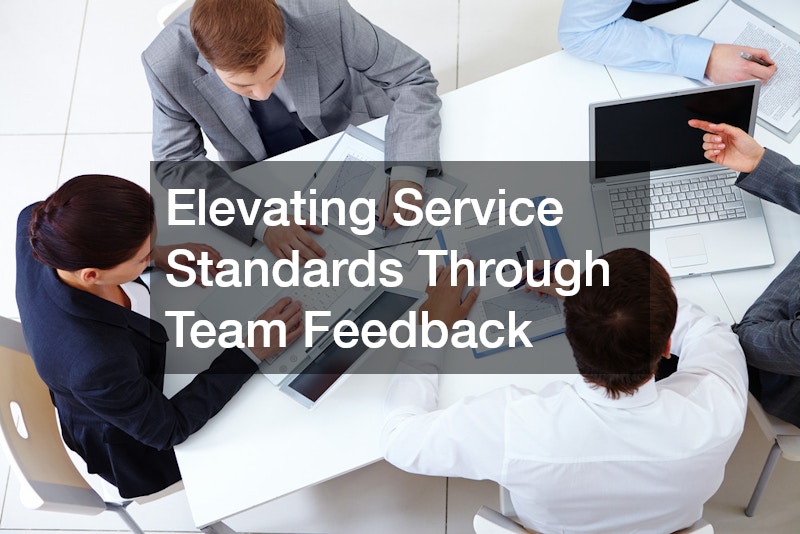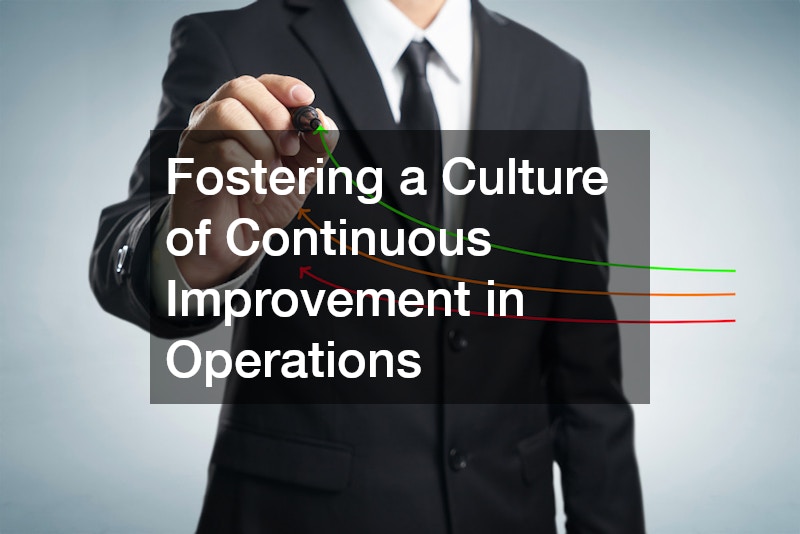Understanding how to improve company efficiency continues to be a paramount objective for businesses desiring to enhance their operational performance. To unlock the potential of a workplace, managers and leaders should critically consider the insights and experiences of their employees. Employee perspectives offer rich, untapped knowledge that when harnessed appropriately, can lead to innovative solutions and sustainable growth.
In this article, we will explore various strategies to integrate employee insights into everyday business processes. We’ll examine the benefits of soliciting team feedback, empowering employees, and fostering open dialogues within an organization. By closely examining these aspects, companies can learn to transform challenges into opportunities while remaining agile and competitive in various industries, including semi towing, grease trap service, and more.
From warehousing services to point of sale systems, every business process can benefit from a critical analysis driven by team input. This article outlines how each segment of a company can tap into employee expertise to achieve operational excellence. We will delve into practical steps and transformative stories on this journey of continuous improvement.
Unlocking Hidden Insights: The Value of Employee Perspectives

Understanding how to improve company efficiency begins with acknowledging the value of employee perspectives. Employees on the front lines of operations have a unique view of processes that can unveil hidden inefficiencies and areas ripe for optimization. Gathering insights from those directly involved in day-to-day activities is often the first step towards transformative change.
By seeking and valuing employee input, organizations can uncover intricate details within operations such as semi towing logistics or grease trap service schedules that may otherwise be overlooked. From parking signage to warehousing services, addressing these hidden insights can pave the way for cost reductions and enhanced productivity. In doing so, companies also foster a sense of belonging and engagement among their workforce.
Moreover, valuing employee perspectives goes beyond mere cost savings; it is about building robust, adaptable systems. When employees see their suggestions implemented, it encourages a culture of ownership and continual improvement. This shift creates an empowered workforce ready to tackle future challenges actively and collaboratively.
Elevating Service Standards Through Team Feedback

One of the primary ways to elevate service standards and learn how to improve company efficiency is by integrating consistent and constructive team feedback. Employees who engage with customers and clients daily can provide critical insights that can redefine service delivery. For example, commercial locksmith services may benefit from feedback about client scheduling preferences or emergency response protocols.
Organizations that prioritize team feedback often create forums or regular meetings where employees can share their thoughts and ideas. This open communication structure can reveal immediate solutions to service challenges, such as optimizing point of sale systems to enhance customer experiences. Through these efforts, businesses improve not only customer satisfaction but also operational efficiencies.
Additionally, team feedback on service standards can lead to innovations that distinguish a company within its industry. Implementing ideas from local pallet delivery drivers or warehouse teams can streamline logistics, bolster reliability, and build a competitive edge. Ultimately, regular team feedback sessions increase accountability and encourage proactive problem-solving across the company.
Fostering a Culture of Continuous Improvement in Operations

To genuinely understand how to improve company efficiency, fostering a culture of continuous improvement is crucial. This culture promotes the idea that every process can be improved, and encourages staff at all levels to contribute to ongoing enhancements. This ethos drives operational excellence in sectors ranging from warehousing services to asphalt repair services.
Promoting a culture of continuous improvement often begins with leadership actively modeling and supporting the change. Leaders who engage with their teams and demonstrate a commitment to improving operations inspire a similar commitment throughout their organization. This can lead to better use of assets like shipping containers, allowing businesses to optimize space and improve logistics planning.
Furthermore, companies that engage employees in conversation about operational opportunities foster creativity and innovation. Employees who feel heard and valued are more willing to contribute to process improvement discussions. This ongoing dialogue encourages experimentation, leading to more efficient work systems and inspiring further innovation.
Empowering Employees to Shape Efficient Workflows

Empowering employees is a key strategy for those wondering how to improve company efficiency. By giving employees the tools and authority to make decisions, businesses can create more agile and responsive workflows. Empowered employees are motivated to optimize processes and contribute directly to enhanced productivity.
In sectors like commercial waste removal and shipping container management, decision-making capabilities can transform operations. When employees are trusted to adjust workflows or make process improvements, they cultivate a sense of ownership and accountability for their roles. This empowerment leads to efficiencies that might otherwise be overlooked by management.
Encouraging employee involvement in workflow design also provides different perspectives on operational challenges. By incorporating employees’ experiences and innovative thinking, organizations can address inefficiencies in greasing trap services or warehousing services. This comprehensive approach leads to more sustainable and scalable operations across the board.
Innovating Solutions: Listening to Frontline Voices
Enhancing how to improve company efficiency involves listening to frontline voices, which often are the first to recognize operational bottlenecks and customer pain points. Employees who directly interact with the production floor, customers, or equipment provide novel insights that can inspire innovation and comprehensive solutions.
Nurturing an environment where employees feel comfortable sharing their observations without fear of dismissal is pivotal. In fields like commercial locksmithing or semi towing, frontline workers’ reflections can lead to updates in protocol or the adoption of new technologies, enhancing overall service delivery and operational efficiency.
Moreover, listening to frontline voices can help identify pressing issues or areas for development early on, reducing the risk of adverse impacts on business continuity. For instance, improving communication among shipping container handlers based on team insights can expedite deliveries and optimize fleet management. Overall, recognizing frontline contributions leads to more robust and effective business practices.
Cultivating an Environment for Idea Sharing and Growth
Building a culture of open communication is essential for those seeking ways on how to improve company efficiency. Establishing channels for idea sharing encourages innovation and fuels continuous growth across all levels of an organization. When team members feel safe to express their opinions and propose new ideas, the entire company benefits from increased efficiency and improved processes.
Organizations can cultivate such environments by creating structured opportunities for collaboration and discussion. Scheduled brainstorming sessions or innovation workshops can capture valuable insights from diverse perspectives, leading to process enhancements in sectors such as semi towing and grease trap service. Additionally, they can uncover innovative solutions that make operations smoother and more effective.
Recognizing and rewarding team contributions to idea sharing also promotes engagement and motivation. Companies that celebrate successful implementation of team suggestions see sustained improvements in productivity and morale, leading to better performance overall. Empowered by the freedom to express themselves, employees become proactive leaders spearheading change in organizations.
Enhancing Operational Excellence Through Collaborative Input
Understanding how to improve company efficiency involves leveraging collaborative input to boost operational excellence. Companies that systematically incorporate employee insights into their processes see improvements in areas like logistics, customer service, and internal communications. Collaboration fosters a multi-faceted approach, enabling diverse departments to align their objectives and processes efficiently.
For instance, fields such as warehousing services and local pallet delivery require seamless collaboration to optimize supply chains and minimize transit times. By gathering input from all stakeholders, companies streamline key operations, driving more intelligent decision-making and reducing costly errors. Collaborative discussions also reveal overlapping tasks or redundancies that can be eliminated.
Beyond providing immediate operational efficiencies, collaborative input drives long-term strategic planning and continuous innovation. Employees engaged in collaborative endeavors have heightened awareness of their company’s goals and align their efforts accordingly. This united approach invariably propels businesses towards sustained success and market leadership.
The Power of Listening: Transforming Challenges into Opportunities
Learning how to improve company efficiency requires embracing the power of listening, which can turn challenges into opportunities. Attentive listening helps identify the root causes of issues and facilitates the development of strategic interventions. When employees feel their voices are heard, they are more likely to contribute positively to tackling organizational challenges.
For businesses like parking signage and asphalt repair services, listening can reveal insights into the nuances of customer needs and environmental constraints. With this understanding, companies can pivot strategies effectively to provide superior service. This commitment to listening builds stronger relationships internally among employees and externally with clients and partners.
Moreover, developing a culture of active listening equips organizations to navigate change more gracefully. By addressing issues promptly and thoughtfully, businesses gain resilience and adaptability, allowing them to transition challenges into avenues for growth. Listening becomes the catalyst for meaningful and sustained improvements that benefit the organization as a whole.
Inspiring Change: How Employee Insights Drive Efficiency
Those seeking to understand how to improve company efficiency must recognize the transformative power of employee insights in driving change. By tapping into the collective wisdom of teams, organizations can expedite process optimizations and elevate overall performance. Employees are well-positioned to suggest alterations that align with real-world applications and constraints.
Nurturing employee-driven change requires creating channels for communication and feedback that transcend traditional hierarchical structures. This ensures that improvements are both relevant and readily adoptable within everyday business practices, whether that involves managing shipping containers or revising commercial waste removal protocols.
As employees witness their insights contributing to tangible improvements, they develop a vested interest in the organization’s success. This deepened connection fosters a proactive culture where every team member seeks ways to contribute to efficiency and innovation, ultimately creating a more agile and responsive organization.
Building Better Processes: Tapping into Team Expertise
To elucidate how to improve company efficiency, businesses should focus on building better processes by capitalizing on team expertise. Employees, through their varied experiences and skill sets, offer invaluable perspectives that can redefine traditional business operations. Harnessing this expertise promotes process improvements that are both effective and sustainable.
One effective strategy is to deploy cross-functional teams tasked with analyzing current processes and identifying areas ripe for innovation. In sectors like point of sale systems and commercial locksmith services, such teams can outline strategies to enhance transaction speed or secure access procedures significantly. These collaborative projects can lead to more efficient, integrated systems that better serve organizational goals.
Moreover, encouraging team members to share specialized knowledge enables companies to innovate within niche markets. It ensures processes are not only refined but also resilient against industry disruptions. Understanding the potential for personalized solutions also gives a company a competitive edge within its sector.
Embracing Feedback for a More Agile Organization
The journey of understanding how to improve company efficiency involves whole-heartedly embracing feedback as a tool to become more agile. An organization’s agility is directly correlated with its ability to listen to, interpret, and act on feedback from employees. As industries and economies evolve, agility becomes crucial for maintaining relevance and sustaining growth.
Entities like semi towing companies must continually adapt to regulatory changes, customer expectations, and technological advancements. By establishing a feedback loop, businesses can keep pace with these developments and implement proactive strategies to remain competitive and efficient. Indeed, responsive companies are better positioned to seize emerging opportunities.
Constantly seeking and responding to employee feedback helps craft a culture that values adaptability and innovation. Organizations must ensure systems are in place to systematically evaluate feedback and integrate insights into their strategic plans. This makes them nimbler, better equipped to embrace change, and ultimately more successful.
From Insight to Action: Turning Suggestions into Solutions
The quest of discovering how to improve company efficiency culminates in the ability to turn insights into actionable solutions. An insight is only as good as the action it prompts; thus, organizations must craft clear pathways from ideas to implementation. By doing so, they can harness the full potential of employee suggestions to optimize operations.
An actionable strategy involves assigning responsibility for evaluating and championing potential solutions. Whether it’s in managing commercial waste or refining point of sale systems, organizations must develop processes to prioritize, test, and refine suggestions in a timely manner. This ensures ideas are integrated effectively and without unnecessary delay.
Furthermore, sharing success stories of employees whose suggestions have been implemented instills trust in the process and encourages ongoing participation. By transitioning insights to solutions efficiently, businesses galvanize their workforce and enhance both morale and productivity. Sustained success stems from a continuous loop of gathering employee insights, translating them into actionable steps, and celebrating resulting achievements.
Encouraging Open Dialogue for Lasting Improvements
A crucial component on the journey towards realizing how to improve company efficiency is encouraging open dialogue for enduring improvements. Constructing an organizational norm of open communication creates a dynamic environment where ideas, suggestions, and constructive criticisms flow freely. This discourse is vital for sustained growth and operational excellence.
Frequent and transparent communication bridges the gap between all levels of a company, whether in logistics planning for warehousing services or refining asphalt repair techniques. It creates a platform where barriers are dismantled, and collaborative problem-solving thrives, leading to progressive solutions that address pressing needs effectively.
Leaders play an essential role in modeling these desired open dialogues by actively participating and demonstrating a willingness to evolve. They must encourage a non-judgmental space for dialogue, reassuring employees that their contributions are valued and respected. This culture of inclusivity strengthens an organization’s resilience and readiness for ongoing advancements.
In conclusion, understanding how to improve company efficiency requires intentionally incorporating employee perspectives into business operations. From valuing insights to empowering employees, each strategic step builds towards creating a more agile and innovative organization. By fostering an environment conducive to open dialogue, companies can continually transform challenges into opportunities for growth.
As industries adapt, those businesses that prioritize teamwork, feedback, and innovation will maintain a competitive edge. Whether in industries such as semi towing, grease trap service, or point of sale systems, unlocking the potential within employee perspectives is paramount for operational excellence and sustainable success.
Ultimately, the journey from insight to action is an ongoing one, requiring active engagement, adaptability, and a commitment to improvement. By embracing employee contributions, companies empower themselves to traverse an ever-changing business landscape with confidence and capability.

